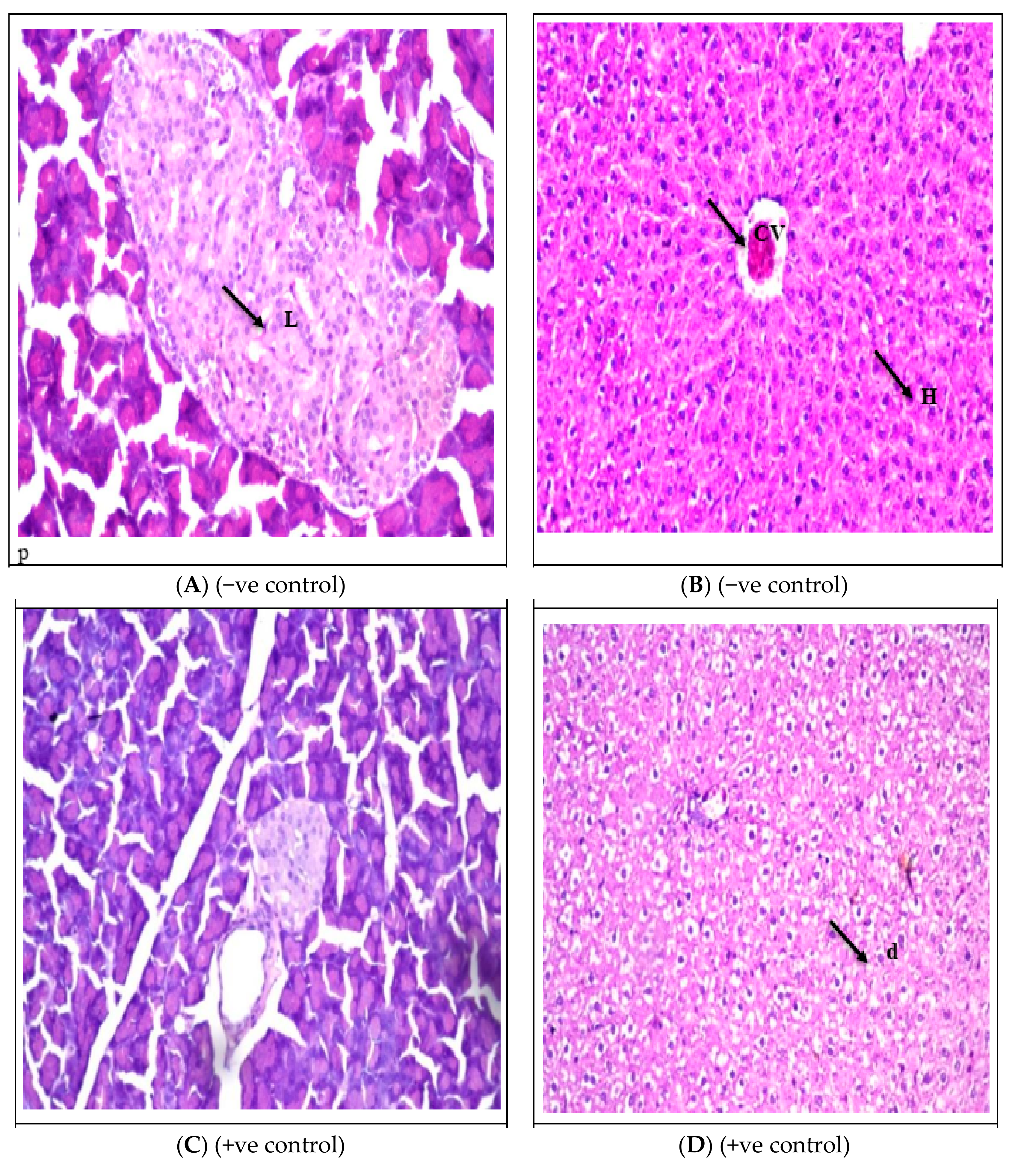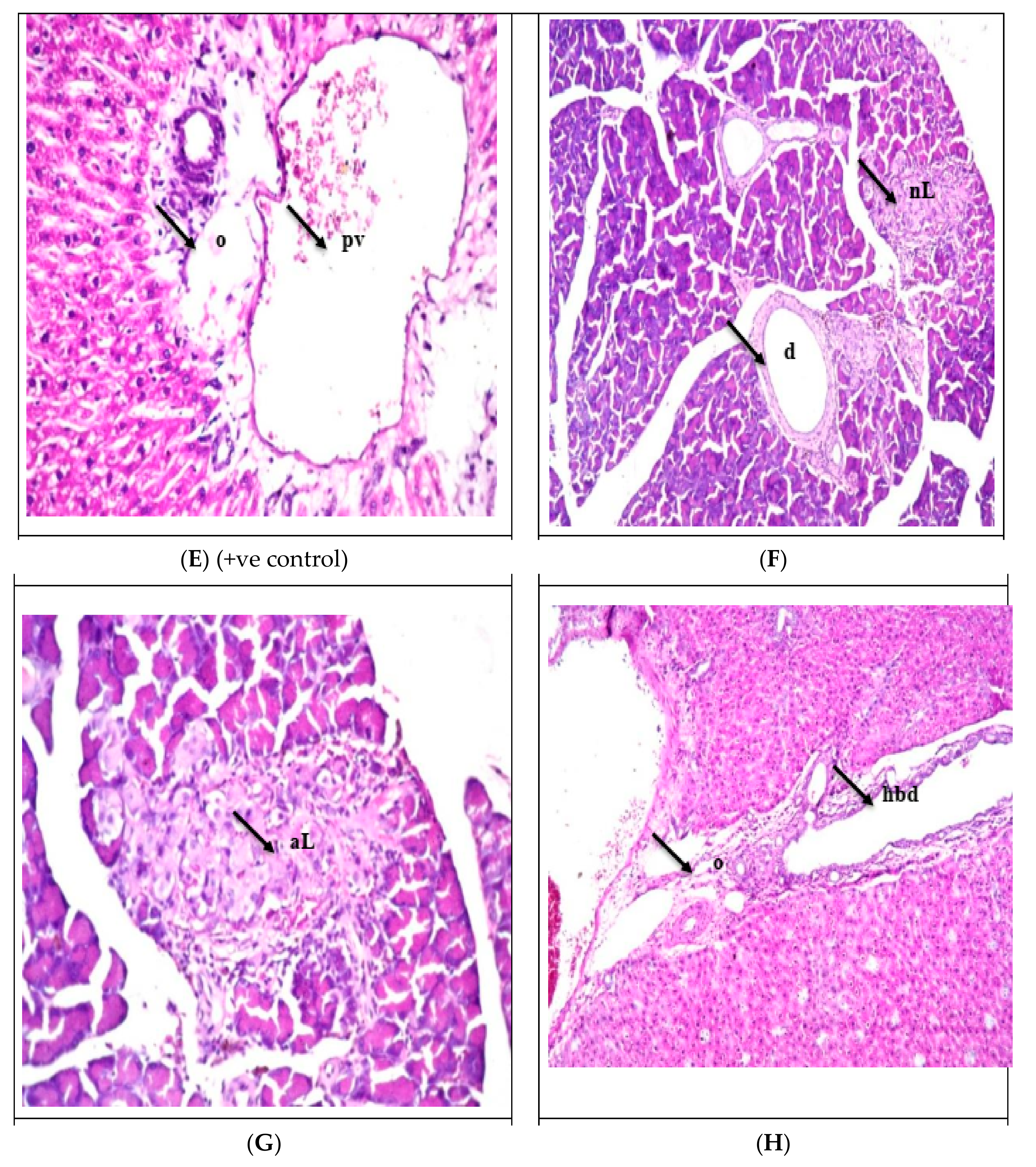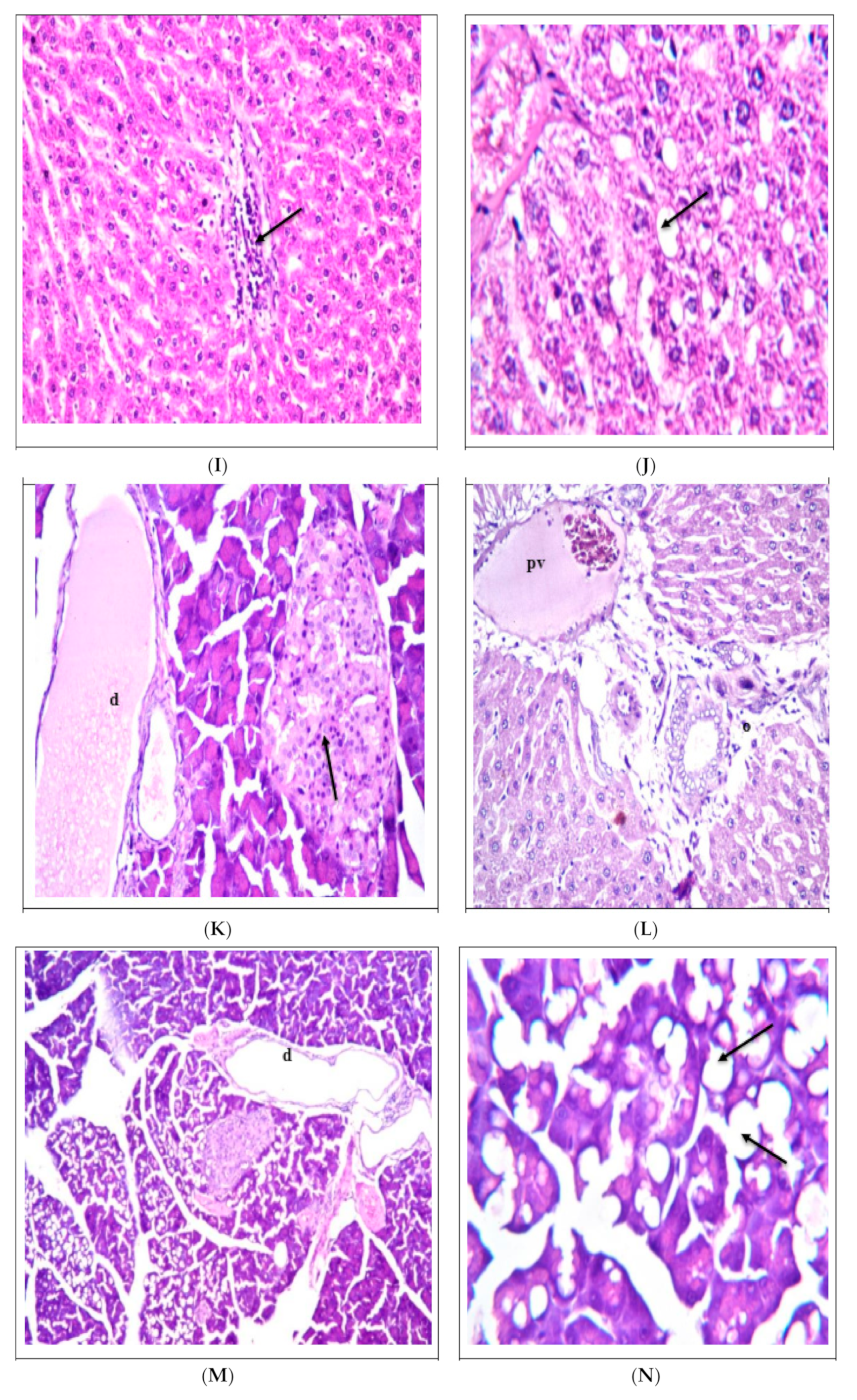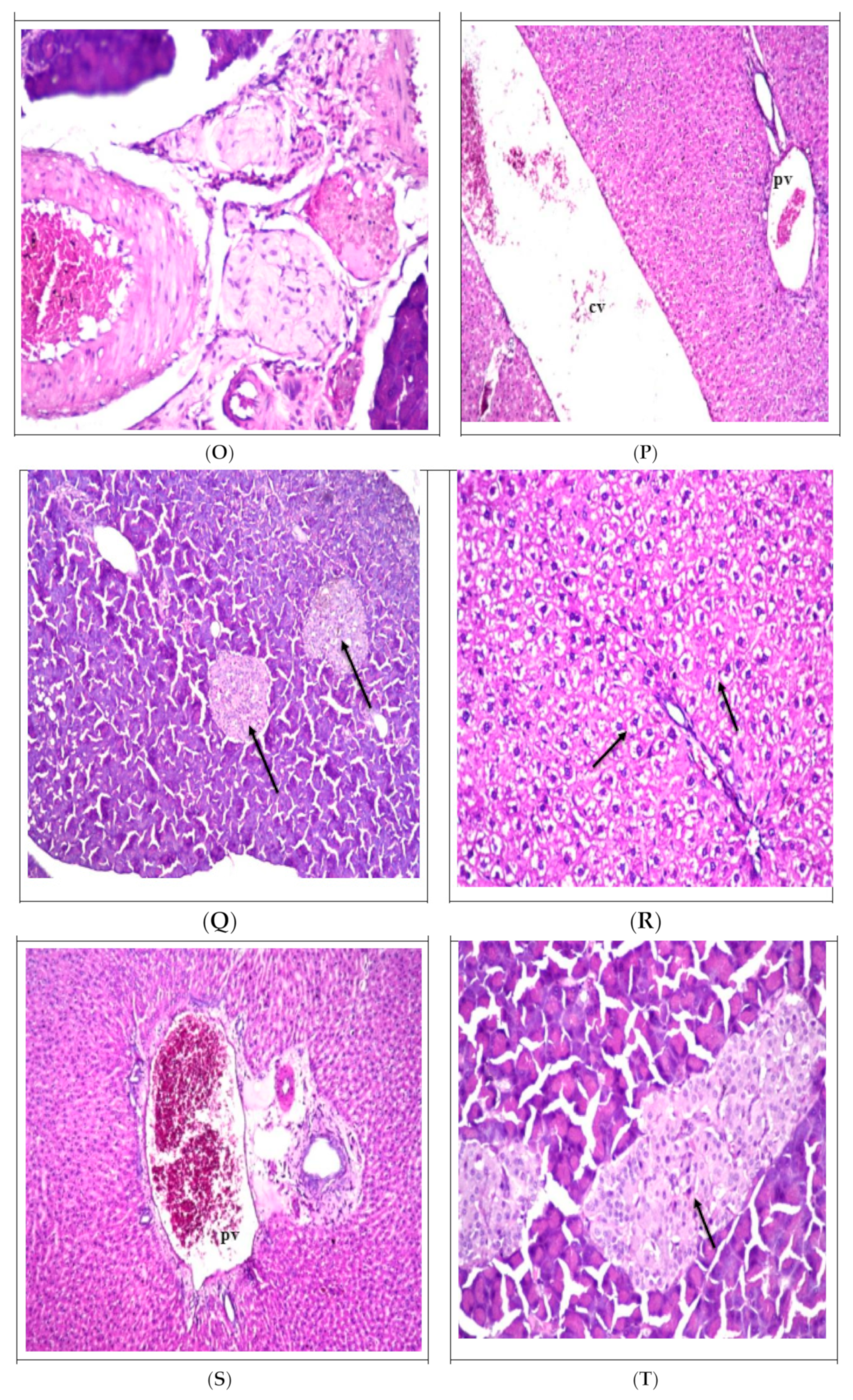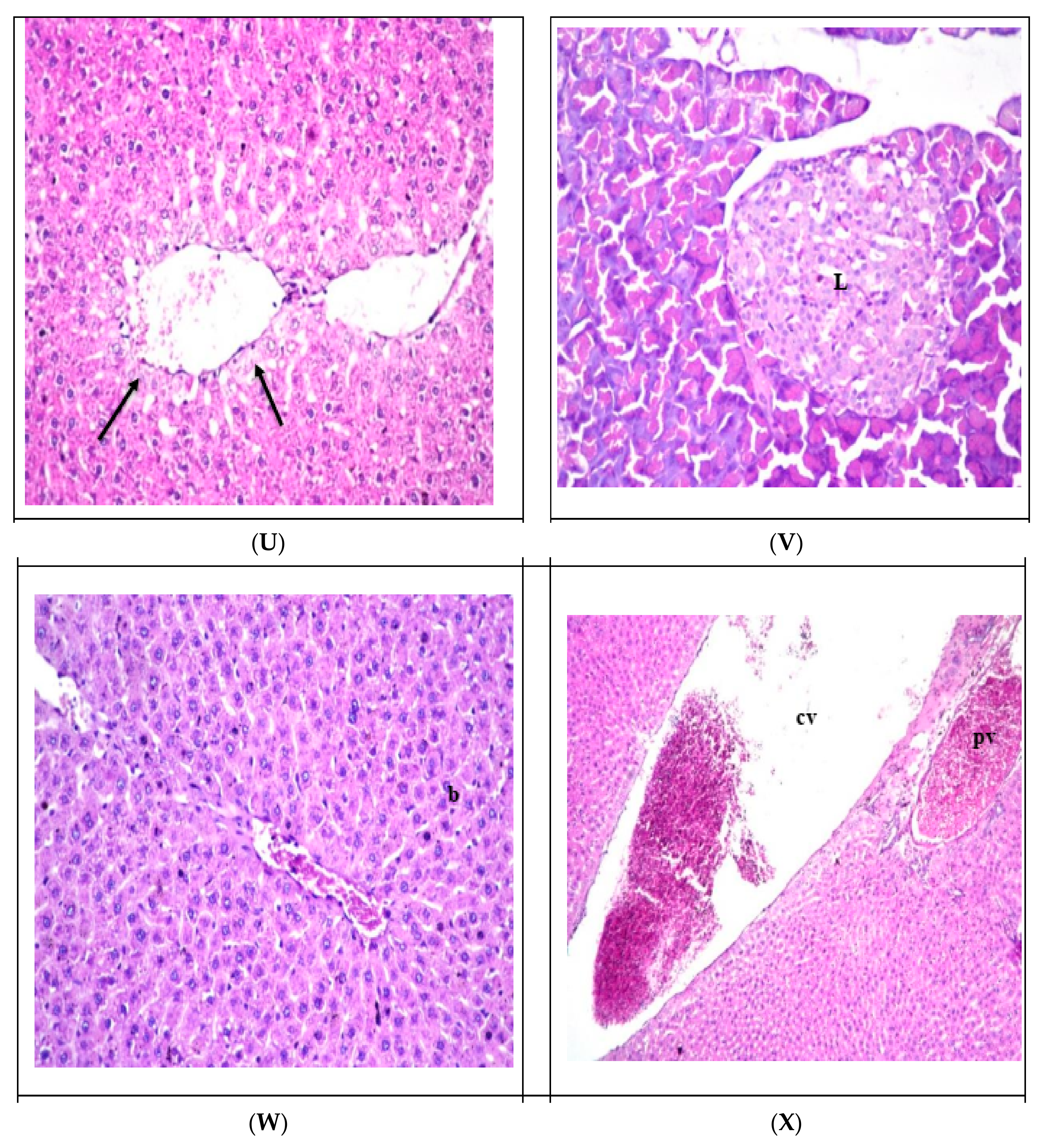3.3. Effect of Supplemented Cupcakes on the Body Weight Gain and Feed Intake Parameters
Compared to the positive control group fed on a standard basal diet or fed on control cupcake, a significant increase (
p < 0.05) in body weight gain (BGW%) of all the rat groups fed on cupcake samples containing BPP, CLP, SLP, and their mixtures, while a significant decrease (
p < 0.05) as compared to the negative group (
Table 4). The positive control group fed on a standard basal diet or a control cupcake showed a lower BGW% (−7.56 and −8.77%, respectively) than the negative group (+27.29%). Despite the increase in BGW% in groups supplemented with BPP (+7.25%), CLP (+8.18%), and SLP (+11.67%), as compared to the positive control group fed on a standard basal diet or fed on control cupcake, but still lower than the negative control (
Table 4). An interesting additive effect could be noted for BWG% in the groups treated with BPP-SLP and CLP-SLP mixtures (1:1
w/
w). However, the diabetic groups fed with CLP-SLP (+16.13%) and BPP-SLP (+14.36%) had a more significant increase in BGW% than the positive diabetic control group, which agreed with the differences in the proximate analysis of agro-wastes, where CLP has the highest fiber content as provided in
Table 1.
The effect of feeding on cupcake samples containing agro-wastes and Stevia on feed intake was recorded and listed in
Table 5. The obtained results cleared a significant decrease (
p < 0.05) in feed intake of the diabetic control group (+) fed on a standard basal diet (74.03 g/rat/28 days) and the diabetic rats’ group fed on cupcake control (75.35 g/rat/28 days) as compared with the negative group control (91.56 g/rat/28 days). The feed intake of treated groups with supplemented agro-wastes and Stevia powders (79.9, 80.61, and 79.70 g/rat/28 days) was significantly lower than the negative group but higher than the positive diabetic control and the diabetic rats fed on cupcake control (100% sugar) groups (
Table 5). The results above agreed with the BWG% discussed above, with the lowest feed intake amount for the CLP-SLP mixture (78.23 g/rat/28 days), followed by the BPP-SLP mixture (78.90 g/rat/28 days).
According to Meliala et al. [
51], the results align with our findings, showing an increase in weight gain for the normal control group and a decrease for the diabetic group after 3 weeks of treatment. Interestingly, the diabetic groups that were fed with banana peel flakes gained more weight significantly than the diabetic control group (
p < 0.05). Moreover, there was no significant difference (
p > 0.05) in food intake between the normal and diabetic groups [
51]. The same pattern was observed in STZ-induced diabetic rats treated with total and soluble banana peel fibers, where the diabetic control group had the lowest body weight, while the normal group had the highest. Additionally, the diabetic groups that consumed different types of fibers had less food intake daily than the diabetic control group, indicating that dietary fiber intake may help reduce the symptoms of polyphagia in T2DM mice [
52]. Along the same line, carrot supplementation induced a time-dependent body weight gain-fed high-fat diet in different groups [
53]. To our knowledge, nothing was reported in the literature concerning the effect of dried carrot leaves on nutritional or biochemical parameters. Consistent with the results of the present study, Ahmad and Ahmad [
54] indicated that aqueous extract from leaves of
Stevia rebaudiana produced a significant (
p < 0.05) reduction in body weight and body weight gain of the rats compared to the negative control. Additionally, Stevia sweetener delivery decreased the amount of feed and water consumed by diabetic rats compared to control groups.
Rats’ bodies may weigh less due to less glucose in the diet being metabolized or consuming less food overall [
55]. This decrease in weight in the rats receiving Stevia extract may be attributable to the high concentration of stevioside, which decreased the rats’ food consumption [
56]. This result concurs with earlier studies that demonstrated a beneficial relationship between the drop in feed intake and the dose of stevioside administered to the rats and the body weight growth percentage [
57].
The effect of feeding cupcake samples containing Stevia and agro-wastes on the fasting glucose level (mg/dL) of diabetic rats was determined weekly through the experimental period (28 days), and the results are listed in
Table 6. Compared to the positive diabetic control group (427.5 mg/dL) and diabetic control cupcake (374.7 mg/dL), a significant decrease (
p < 0.05) in glucose levels of all diabetic groups fed on the supplemented cupcake with Stevia and agro-wastes, ranging from 195.1 to 180.9 mg/dL at the end of the experimental period. However, as expected, the negative control group had the least glucose level (91.8 mg/dL) at the end of the testing period, as given in
Table 6. After 4 weeks of the experiment, the lowest glucose level was recorded for the CL-SLP mixture due to the additive effect compared to using SLP or CLP separately in the cupcakes formula (
Table 6).
In line with Meliala et al. [
51], standard diets containing banana peel flakes have been found to significantly reduce blood glucose levels in comparison to a diabetic control group. Additionally, Louis et al. [
4] observed a similar trend in diabetic rats fed with a diet supplemented with carrot powder, which resulted in lower blood glucose levels in comparison to the diabetic control group. In a study involving diabetic rats, Stevia aqueous extract significantly restored fasting blood glucose levels towards normal from the 1st week to the 8th-week experiment [
54]. Previous research has shown that stevioside is effective in controlling blood sugar levels by improving insulin secretion, sensitivity, and utilization in insulin-deficient rats [
58]. Moreover, another study suggests that Stevia extract contains certain biomolecules that could potentially make the insulin receptor more sensitive to the hormone or stimulate the islets of Langerhans beta cells to release insulin. Both of these actions could help improve the body’s enzymes that break down carbohydrates and restore normal blood glucose levels [
59].
Stevia rebaudiana leaves’ extract has been found to reduce random and fasting blood glucose levels in rats by reviving the β-cells of the pancreas, reactivating the glycogen synthase system, enhancing insulin secretion, and increasing liver glycogen level [
60].
Table 7 presents the results of a study on the effects of cupcake samples containing Stevia and agro-wastes on serum liver functions, ALT, AST, and albumin of alloxan-induced diabetic rats. The study found that the positive control group, which consisted of diabetic rats fed on a standard diet or cupcake control, had significantly higher levels (
p < 0.05) of ALT and AST (64.1 and 65.5 mg/dL, respectively, for the standard diet group and 61.9 and 62.7 mg/dL, respectively, for the cupcake control group) compared to the negative control group (34.7 and 32.9 mg/dL, respectively). However, supplementing the cupcake with Stevia and agro-wastes and Stevia led to reduced AST and ALT concentrations compared to the positive control group, but they were still higher than the negative control group (
Table 7). Among the supplemented groups examined, SLP alone or in an additive mixture with CLP showed the lowest ALT and AST concentrations. The study also found a significant decrease (
p < 0.05) in the albumin level of the positive control group (4.5 mg/dL) and cupcake control group (4.7 mg/dL) compared to the negative control group (6.9 mg/dL). The supplemented cupcake samples had a lower albumin content than the negative control group (5.0, 5.4, 5.6, 5.3, and 5.8 mg/dL) but higher than the positive control group. The highest albumin level was observed in the additive effect of the SLP-CLP mixture, which was higher than the cupcake control, the positive control, or the samples supplemented with Stevia or other separate agro-wastes.
In line with the above results, Assi et al. [
61] showed that the administration of Stevia extract for STZ-induced diabetic rats significantly reduced hepatic parameters (ALT and AST). Increased levels of these biomarkers point to increased tissue permeability, injury, or necrosis brought on by the production of free radicals in all tissues due to protein glycosylation and glucose autooxidation [
62]. The unaltered food intake and plasma ALT and AST levels during the fortification of a high-fructose diet with carrot juice imply that the oral gavage administration did not cause stress to experimental animals [
63]. The impact of banana fruit and peel on liver function enzymes of diabetic rats with induced hepato-toxicity was discovered by Zakaria et al. [
64]. Comparing the diabetic hepatotoxic group’s serum ALT, AST and ALP activities to the corresponding value in the normal control group revealed a substantial increase (
p < 0.05) in each enzyme activity. The fast release of these enzymes from the cytoplasm into the blood circulation following plasma membrane rupture and cellular injury may cause increased serum AST and ALT levels. Elevated ALT is seen as a more sensitive signal and is typically accompanied by increased AST. High serum transaminases are thought to be a sign of hepatic damage [
65]. The mean value of ALT, AST, and ALP levels significantly decreased (
p < 0.05) when diabetic hepatotoxic rats were given dried banana fruit and its dried peel compared to the positive control group. According to the research by Mosa and Kkalil [
66], eating dried or fresh banana peels may change a patient’s risk of developing acute liver failure.
The significant reduction in albumin in the diabetic control (positive) compared to the negative control or treated groups with supplemented cupcakes is due to the glycation of renal matrix proteins causing alterations in kidney architecture and increased basement membrane permeability, resulting in nephropathy [
67]. These gradual alterations build up over time, eventually leading to renal failure. Preventing protein glycation can be very helpful in preventing the formation of such alterations. Microproteinuria and albuminuria, vital clinical indicators of diabetic nephropathy, and/or enhanced protein catabolism could explain the decrease in total protein and albumin percentage [
68].
Based on the findings given in
Table 8, the diabetic groups that consumed cupcake samples containing agro-wastes and Stevia powders demonstrated a significant reduction (
p < 0.05) in urea, uric acid, and creatinine compared to the positive control group and the diabetic rats that consumed regular cupcakes. The SLP-CLP mixture added to the cupcakes showed the best results, with urea, uric acid, and creatinine levels of 47.65, 4.94, and 1.16 mg/dL, respectively, due to the additive effect of the ingredients. The negative group had the lowest kidney function parameters among all the tested groups (as shown in
Table 8).
In agreement with the above results, treatment of diabetic rats with Stevia extract ex-pressed a significant decrease in renal indicators (urea and creatinine), as Assi et al. [
61] reported. When diabetic rats were fed a diet supplemented with banana fruit and its peel, the mean values of uric acid, creatinine, and urea decreased significantly (
p < 0.05) compared to the positive control group. Furthermore, neither the banana fruit nor its peel caused any discernible alterations in renal functioning among the treatment groups [
64]. Rats exposed to gentamicin consistently had higher serum urea, uric acid, and creatinine levels. It was discovered that these levels (
p ≤ 0.01) considerably decreased in a dose-dependent way in the groups receiving carrot extract, which was also supported by histological observations [
69]. It was revealed that circulating lipids bind to and become trapped by the extracellular matrix, where they are oxidized, increasing the reactive oxygen species generation, which could damage the structure and function of diabetic kidneys [
70]. Therefore, treatment with flavorings in nano-encapsulated and nonencapsulated forms inhibited lipid alterations, which could be one explanation for its possible renoprotective activity.
The results presented in
Table 9 show that diabetic groups who consumed cupcakes fortified with agro-wastes and Stevia powders experienced a significant decrease (
p < 0.05) in total cholesterol, triglyceride, and LDL levels. This decrease was particularly noticeable in cupcakes that were supplemented with the CLP-SLP additive mixture. In comparison to the positive diabetic control and cupcake control groups, the total cholesterol, triglyceride, and LDL levels of the positive control group decreased from 197.5, 115.1, and 70.8 mg/dL to 130.5, 60.9, and 47.6 mg/dL, respectively, for the diabetic group fed on cupcakes supplemented with CLP-SLP mixture. In contrast, there was a significant increase (
p < 0.05) in HDL levels for diabetic groups treated with BPP, CLP, SLP, and their mixtures (27.6, 31.2, 32.9, 30.2, and 36.7 mg/dL, respectively) compared to the positive diabetic control and cupcake control groups (17.9 and 19.7 mg/dL, respectively). This lipid-lowering effect could potentially prevent cardiovascular disease in diabetes, which is also supported by the decreased glucose levels in the treated groups, as discussed in
Table 6.
The previous findings agreed with Soleti et al. [
53], where a high-fat diet with carrot supplement showed antihyperglycemic and lipid-lowering activities due to its effect on improving pancreatic β-cells function. It has been established that various metabolic and regulatory abnormalities that occur during diabetes lead to hyperlipidemic conditions in people with diabetes, while increased TC, LDL-C, and TG levels in the blood cause diabetic dyslipidemia [
71]. Moreover, Wang et al. [
49] revealed that the serum TC, TG, LDL-C, and HDL-C levels of the diabetic mice were significantly increased compared with the negative control group. After supplementing banana fibers, the lipid profile parameters decreased significantly. Treatment of diabetic rats with Stevia extract caused a significant decrease in serum cholesterol and TG compared to untreated rats. In contrast, diabetic rats treated with Stevia extract showed a significant elevation in the HDL level compared to control diabetic rats [
61].
